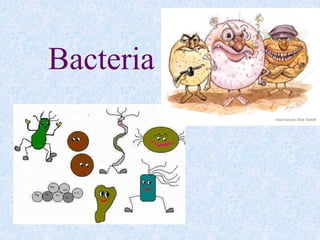
Two Kingdoms and Characteristics of Bacteria
- 1. Bacteria
- 2. Two kingdoms of bacteria: •Eubacteria – “true” bacteria •Archaebacteria – oldest organisms on earth, live in extreme conditions
- 3. Bacteria are: •Unicellular •Prokaryotic…which means? Fact: Each square centimeter of your skin averages about 100,000 bacteria. A single teaspoon of topsoil contains more than a billion (1,000,000,000) bacteria.
- 4. Bacteria Characteristics • Some bacteria are aerobic, meaning that they require oxygen in order to survive. Other bacteria are anaerobes, meaning that they do not require oxygen to survive. • Most bacteria are harmless and offer beneficial functions to living things and humanity.
- 5. Bacteria contain: •a singular, circular piece of DNA •tiny circular pieces of DNA called plasmids •ribosomes
- 7. Bacteria reproduce: Bacteria exchange plasmid DNA. This is how bacteria become antibiotic resistant. sexually using conjugation.
- 8. Bacteria have cell walls made of: •peptidoglycan (polysaccharide linked with chains of amino acids). •this may be covered with an outer membrane of lipopolysaccharide (chain of sugar with a lipid attached).
- 9. Some bacteria: • have a gelatinous layer called a capsule surrounding the cell wall. • form thick-walled endospores around chromosomes when they are exposed to harsh conditions (drought, high temperatures) - these types cause botulism
- 10. Some bacteria have: • flagella for locomotion. • pili (short, thicker outgrowths that help cell to attach to surfaces)
- 11. • Bacteria can be moved by air and water currents, and on any surface such as clothing, hands, or any object.
- 12. ¨Three bacterial shapes: 1.Rod shaped are called bacillus(i) 2.Sphere shaped are called coccus(i) 3.Spiral shaped are called spirillum(I)
- 13. Gram stains: • Important in medicine because provides information for treatment of bacterial disease. •Bacteria stain either gram positive (purple) or gram negative (pink). •Gram positive tend to respond to penicillin and like antibiotics. •Gram negative respond to types of antibiotics unrelated to penicillin.
- 14. Crystal violet dye Iodine Alcohol Safranin Gram Stain Process: Purple Decolorizes Pink Counterstain
- 15. A Gram Stain is usually performed on a smear preparation that has been heat fixed. One function of fixation is to secure (fix) the cells to the slide.
- 16. Gram positive = purple because of large amount of peptidoglycan in cell wall. Polymer consisting of sugars and amino acids that forms a mesh- like layer outside the plasma membrane of eubacteria.
- 17. Gram negative = pink because¨ lipopolysaccharide membrane is removed by alcohol and thin peptidoglycan layer allows dye to escape. (LPS) is a large molecule consisting of a lipid and a polysaccharide (carbohydrate) joined by a covalent bond.
- 18. • work by preventing cell wall formation, breaking up cell membranes, or disrupting chemical processes. •Antibiotics cannot treat viral infections.
- 19. There are three types of bacteria based on how they obtain energy: heterotrophs, photosynthetic, and chemoautotrophs. This is the anthrax bacterium.
- 20. 1.Most are heterotrophs: a. Decomposers – feed on and recycle organic material b. Pathogens – parasitic, disease-causing bacteria • Either attack cells or secrete toxins c. Nitrogen-fixing bacteria (Rhizobium) • Found in nodules of soybeans, peanuts, alfalfa, and clover • Convert atmospheric nitrogen (N2) into ammonia, called nitrogen fixation. • Used in crop rotation
- 21. Decomposers • Bacteria are decomposers, they break down the chemical elements inside other living or dead organisms. Some bacteria live in the intestines of humans and animals Rhizobia bacteria convert nitrogen gas into other substances that help plants grow.
- 23. Nitrogen fixing bacteria in the nodules of roots Nitrogen-fixing bacteria (Rhizobium)
- 24. 2. Some, like Cyanobacteria, are photosynthetic. •These are autotrophs that use the sun’s energy to make food. This bacteria has chlorophyll and uses the process of photosynthesis to produce food very much like a plant.
- 25. 3. Chemoautotrophs •Obtain energy by removing electrons from inorganic molecules such as ammonia and methane to make food. •Examples: Nitrobacter and Nitrosomonas - live in soil - have a crucial role in nitrification (turn ammonia into nitrates, the form of nitrogen commonly used by plants).
- 26. Some Good Bacteria • Lactic acid bacteria have been used to ferment or culture foods for at least 4000 years. • Examples: products like yogurt and cheese • Wastewater bacteria feed on everything from solid human waste matter to last night's leftovers. As the bacteria eat, they convert organic matter to carbon dioxide, releasing electrons, the basic element of electrical current.